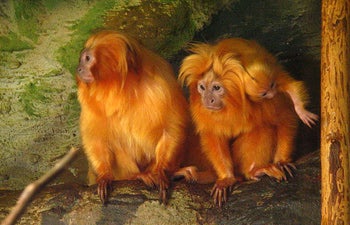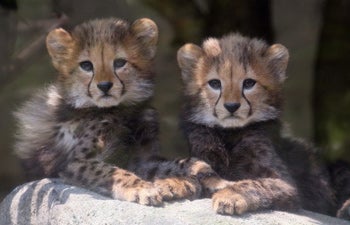They’re Both a Rare Breed
We know that the extinction of species is irreversible and geographically concentrated. We know that tropical deforestation is the main driver of terrestrial extinctions.
So what will it take to slow the quickening pace of extinctions? Conservation biologist Stuart Pimm knows. A lifelong protector of the Earth’s biodiversity, Pimm is being recognized for his efforts. He and fellow conservation biologist Laurie Marker have earned the 2010 Tyler Prize for Environmental Achievement.
Marker is executive director and founder of the Cheetah Conservation Fund (CCF), a nonprofit based in Namibia, Africa. Her foundation is the reason the big cats of Africa’s bush country —the world’s fastest land mammal that reaches the speed of 75 mph — are not closer to extinction.
Considered the “Nobel Prize of environmental achievement,” USC administers the Tyler Prize, including gold medals and a shared $200,000 cash award. The effort is housed in USC College.
Michael Quick, executive vice dean in the College, hosted the April 22 awards and lecture ceremony. The event took place on Earth Day at the Davidson Conference Center, followed by a reception at the Tyler Environmental Prize Pavilion, both on University Park campus.
“This is the 37th year that the Tyler Prize has been given, and USC is very proud of its role in its administration,” Quick said.
Quick introduced Marker and Pimm, the 66th and 67th Tyler Prize recipients, respectively.
“These two outstanding conservation scientists are being recognized ‘for their scientific contributions, their understanding of ecosystem functions, and for their applications of this knowledge to the management and restoration of ecosystems to the benefit of their inhabitants,’ ” he said.

Stuart Pimm chairs Saving Species, an all-volunteer organization that evaluates projects protecting endangered species, including the Save the Golden Lion Tamarin non-profit organization. The small Brazilian monkey shown here has a wild population of a little more than 1,000 and a captive population of nearly 500.
During his lecture, Pimm explained how human impact is causing species to become extinct 100 to 1,000 times faster than anticipated, and outlined practical solutions to the crisis. The Doris Duke Chair of Conservation Ecology at Duke University’s Nicholas School of the Environment discusses global biodiversity in his 1991 book, The World According To Pimm: A Scientist Audits the Earth.
Deforestation is not only the principal driver of extinction; it contributes 50 percent of carbon dioxide seeped to the atmosphere each year, Pimm said. That’s more carbon emission than all cars and trucks worldwide.
“The problem as far as species extinction is concerned is that the tropical forest is where the wild things are,” Pimm said. “It’s where the greatest number of species is found.”
In the Ecuadorean Andes, where Pimm has conducted research, there are as many as 30 different amphibian species. In addition to a Madagascan jungle or an Everglades prairie or the savannahs of southern Africa — where he holds a faculty appointment at the University of Pretoria in South Africa — he regularly visits the southeastern part of Brazil for his in-depth studies.
“Besides losses in the northern Andes, the Caribbean and parts of Mexico, there’s been a huge amount of deforestation in the rain forest of Brazil,” he said, adding, “There are very few species of birds in Canada, the country is at the bottom of biodiversity. But things get exciting when you start speaking Spanish and start to get really exciting when you start speaking Portuguese.”
Species extinction in that coastal strip of Brazil is happening in the greatest numbers in the Americas. One issue is conservation funding. For example, the world’s leading conservation organization, World Wildlife Fund, has only a small presence in coastal resorts.
“If we’re going to save species from extinction this isn’t something that as scientists and as activists that we can simply leave up to the big conservation groups that I call ‘Bingos.’ The Big NGOs,” Pimm said. “Biodiversity is too important to leave to the Bingos.”
He emphasized the importance of working with the indigenous people, pointing to a 2008 Brazilian Supreme Court ruling that paved the way to create a reserve in the Amazon, one of the largest protected indigenous areas in the world. Rice growers who had lived in the territory for two decades had petitioned the court to take over the land.
Pimm also noted that Norway has launched an initiative to allocate up to 3 billion krone ($440 million) each year for tropical forest conservation. With a population of 1.5 percent of the United States, Norway is the largest international funder of rainforest conservation.
“Since Norway is saving the world, I hope this will appeal to [U.S.] patriotism,” Pimm said. “So that you will rise up and say, ‘We as Americans ought to be saving the world, too.’ ”

With the largest population of cheetahs in Namibia, the population halved in the 1980s, leaving fewer than 2,500. Since the beginning of the 1990s, when Laurie Marker began her work with the farming community, a gradual change has occurred in Namibia, and over the last few years the number has stabilized. Photo courtesy of the Cheetah Conservation Fund.
When discussing her life’s passion, Marker said the cheetah once roamed Africa, Asia and India. One hundred years ago, there were roughly 100,000 cheetahs. That number has dwindled to about 10,000 cheetahs worldwide, most of which exist in Namibia.
Marker recalled visiting Namibia in the ’70s and hearing about farmers killing cheetahs, or live trapping them. Between 1980 and 1990, as many as 10,000 cheetahs were slain in Namibia. At the time, Marker was running a wildlife safari in Oregon.
“I was going over to Africa and hearing about the cheetah killings and seeing this from the farmers and I thought, ‘somebody must care.’ I thought one of those larger organizations would probably do something and if I told enough people maybe somebody would care about the cheetahs. And nobody did. So I set up a foundation,” said Marker who in 2000 was named one of Time magazine’s “Heroes for the Planet.”
“And then I moved to Namibia to work with the farming community.”
She began going door-to-door, meeting with the farmers. She learned how they farmed, what kind of livestock they had, how they got water, about the area’s wildlife. Between 1991 and 1993, she conducted a survey to identify components of farmland ecosystems necessary to sustain a healthy cheetah population and farm management practices that reduce loss from predators. She studied conservation management strategies beneficial to both the cheetah and farmers. The survey resulted in the publication of her book, Cheetah Survival on Namibian Farmlands.
She and the farmers helped developed a program that her foundation research revolves around today. Her program was the first long-term comprehensive study of predators outside of protected land.
“Back in the ’70s and ’80s, it was great to be able to go and watch animals and game reserves; they were very beautiful and I knew what a cheetah looked like,” Marker said. “But I decided to go and brave it with the farmers and talk with them and learn about what their problems were. And teach them more about the cheetah and how possibly they could live with them.
“To save the cheetah means actually having to live with the cheetah.”